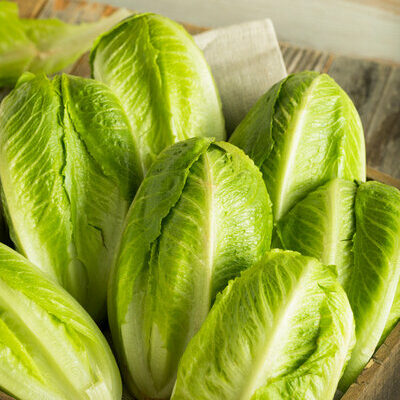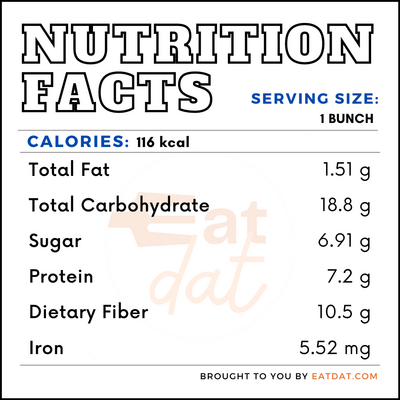
Romaine Lettuce
also known as Cos Lettuce
What is Romaine Lettuce?
Romaine lettuce is a type of lettuce commonly used in North American, Middle Eastern, and European cuisines. It has a deep green color and elongated leaves. The name romaine lettuce refers to its coming through Rome into Europe.
- However, the name cos lettuce is derived from the Arabic word for lettuce, khus.
- Due to its mild flavor and crispiness, this lettuce is an integral ingredient in both the Waldorf salad and Cobb salad.
Some common ways to use lettuce in the kitchen include:
- Salads
- Soups
- Wilted
- Grilled
- Braised
- Sauces
- Wraps
- Rolls
- Smoothies
- Slaw
Origin
Wild lettuce originated in the Mediterranean region. The first records of its cultivation go back 6,000 years ago to Ancient Egypt. However, certain Greek writers have written about it being consumed in the Middle East even earlier. By the 5th century AD, it had already spread eastward to China and other eastern countries. Lettuce was popular in Ancient Rome and it is believed that romaine lettuce may have originated there. By the 1500s, it had been introduced from Italy into France and Germany. Within two hundred years, it was widely popular in Europe.
Commercial production
China, the USA, India, Spain, and Italy are the main producers of lettuce. The main exporters are Spain, the USA, Mexico, the Netherlands, Italy, China, Belgium, France, and Germany. Romaine lettuce is a cool climate crop. As the temperature becomes warmer, the lettuce can become more and more bitter. It requires rich loamy or sandy soils with good drainage. Lettuce is generally grown on raised beds. The leafy vegetable is harvested whole manually and sprayed with chlorinated water to disinfect, before packaging.
Romaine lettuce has a shelf life of up to three weeks, if kept in the refrigerator. Also, lettuce stays fresher longer, if stored wrapped in a damp kitchen towel rather than a plastic bag.
Nutrition
Nutritional profile for romaine lettuce (1 bunch):

Romaine lettuce is rich in calcium, magnesium, phosphorus, potassium, vitamin C, folate, vitamin A, carotene, lutein + zeaxanthin, and vitamin K. Consumption of romaine lettuce assists in better sleep due to the presence of lactucin. Also, it contains polyphenols and antioxidants. Regular consumption may assist in better regulating blood sugar and reduce the risk of obesity and diabetes. The vitamin A present in the vegetable may help in improving eye health.
However, romaine lettuce and other leafy greens can easily be infected from the dung of animals which are infected and are used as manure. There have been multiple outbreaks of E.Coli in North America in recent years due to this. As a result, it is vital to always properly wash lettuce before consuming it.
Romaine lettuce recipes
This lettuce is most often used in salads. However, it also works well in soups, juices, or wraps. Additionally, it may be served grilled, sauteed, or as a garnish. Here are a few recipes to try:
- Grilled Romaine Lettuce
- Italian Salad
- Fattoush
- Lettuce Dal
- French Bistro Salad
- Lettuce Sandwich
- Vietnamese Spring Rolls
- Turkey Club Lettuce Wrap
- Romaine Salad Cups
- Egg Caesar Salad
- Laphet Thoke
FDA regulations
The USDA regulates the grades and standards for romaine lettuce and specifies what constitutes damage. In addition, the FDA recently released the results of a sampling of North American romaine lettuce crops for pathogens that cause foodborne illnesses. With the results of this study, the organization updated their plan released in early 2021 that takes steps to advance leafy greens safety
References
Ynes Ortega, Romaine Lettuce, A food production wiki for public health professionals, Food Source Information: Colorado Integrated Food Safety Center of Excellence, https://fsi.colostate.edu/romaine-lettuce-2/
Kim, Hae Dun et al. “Sleep-inducing effect of lettuce (Lactuca sativa) varieties on pentobarbital-induced sleep.” Food science and biotechnology vol. 26,3 807-814. 29 May. 2017, doi:10.1007/s10068-017-0107-1, https://www.ncbi.nlm.nih.gov/pmc/articles/PMC6049580/
Henderson, Gregory C. “Lettuce romaine calm and manage our glycemia: adding leafy greens to a meal may improve postprandial metabolism.” Lipids in health and disease vol. 20,1 67. 15 Jul. 2021, doi:10.1186/s12944-021-01495-9, https://www.ncbi.nlm.nih.gov/pmc/articles/PMC8281635/
